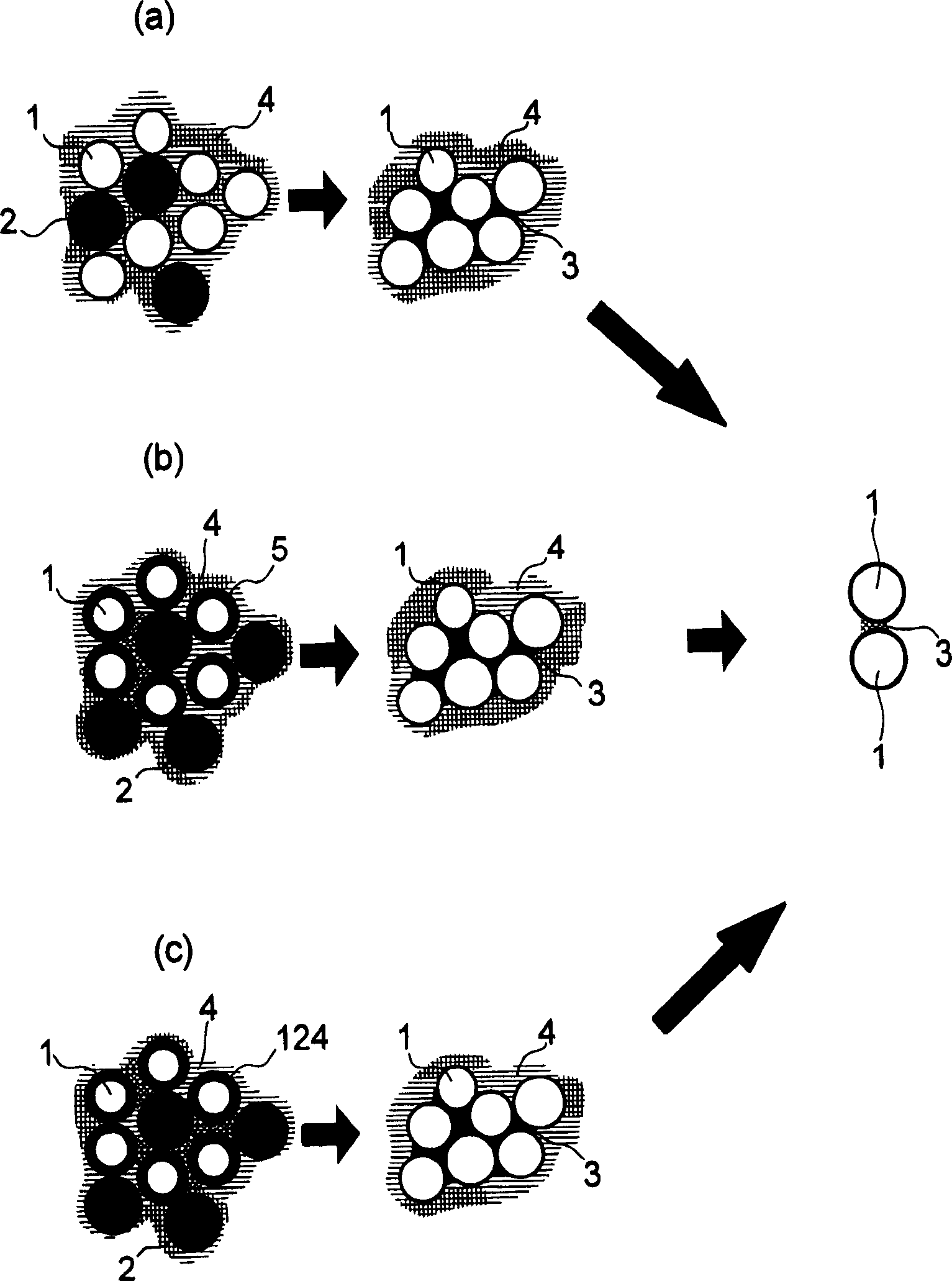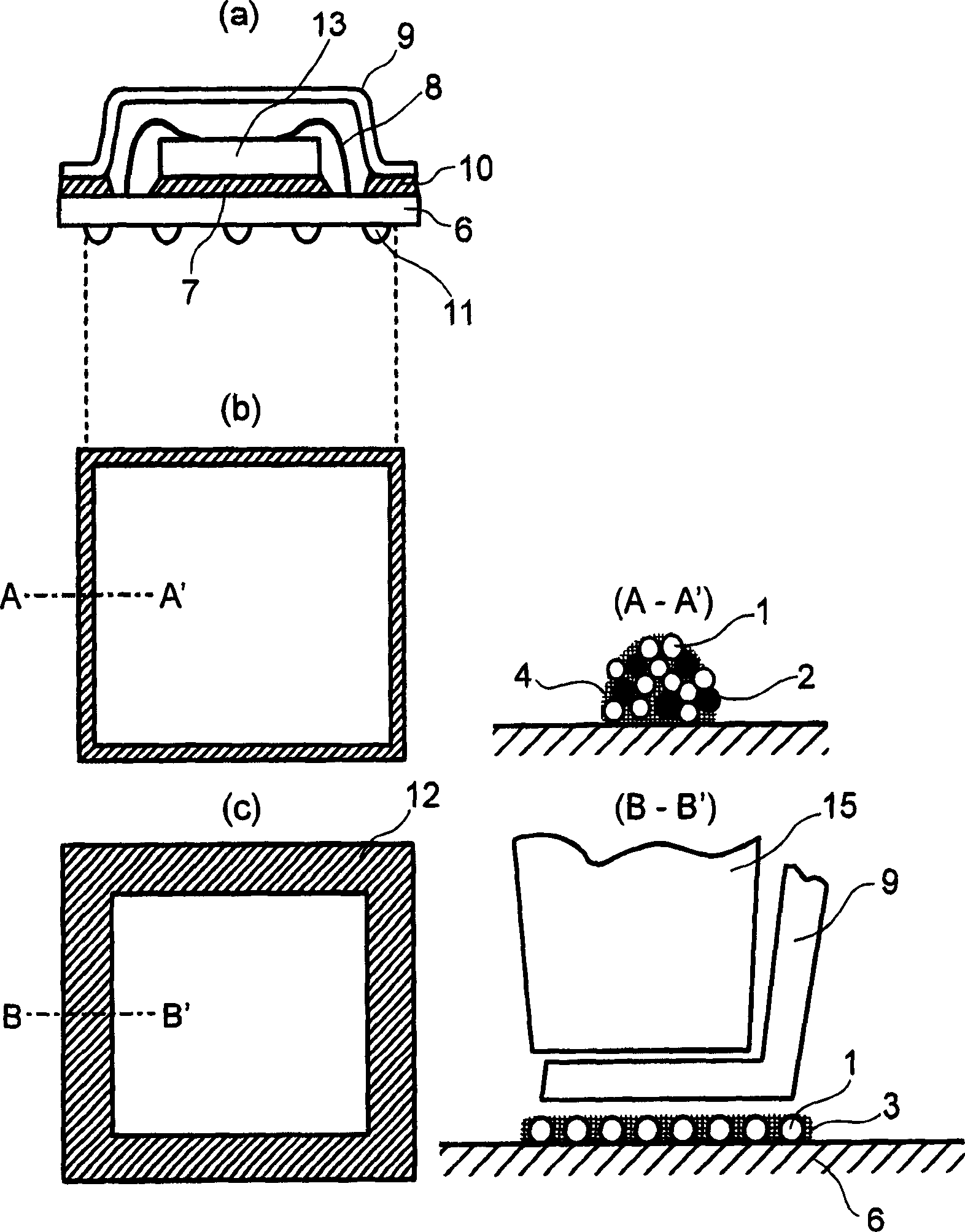Soldering flux
A technology of solder and solder balls, which is applied in the field of solder joint technology of lead-free solder materials, can solve the problems of high cost, no low-temperature solder, damage to Si chips, etc.
- Summary
- Abstract
- Description
- Claims
- Application Information
AI Technical Summary
Problems solved by technology
Method used
Image
Examples
Embodiment 1
[0057] figure 1 (a) to figure 1 (c) shows a conceptual model of a bonding structure according to the present invention. The figure also shows a situation before welding and another situation after welding. figure 1(a) shows a process in which Cu balls 1 (or balls of Ag, Au, CuSn alloy, etc.) with a particle size of about 30 micrometers are properly diffused through solder 4 and Sn-based particles with a particle size of about 30 micrometers. Example of solder paste for solder ball 2 (melting point: 232 degrees Celsius). When this solder paste is subjected to reflow at a temperature not lower than 250 degrees Celsius, the Sn-based solder ball 2 will melt, and the molten Sn3 will spread so that the molten Sn3 will wet the Cu ball 1 and appear relatively uniformly on the solder paste. Between Cu balls 1. Thereafter, the Cu balls 1 and the molten Sn3 react with each other so that the respective Cu balls 1 are connected to each other by means of a compound of Cu and Sn (main...
Embodiment 2
[0079] exist figure 2 In (a), the semiconductor device 13 is bonded to the bonding substrate 6 using an Au-20Sn solder 7 or the like. After wire bonding using gold wire 8 or the like, the outer peripheral portion of the cap 9 produced by applying NiAu plating to an Al plate, an iron Ni plate, or the like is reflowed using the above-mentioned non-clean type solder paste 10. bonded to the bonding substrate 6. In this case, when insulating characteristics are deemed important, bonding in a nitrogen atmosphere using solder with a chlorine-free flux is required. However, when wettability cannot be guaranteed, RMA type weakly reactive rosin can be used for encapsulation. It is not necessary to ensure complete encapsulation or sealing of the semiconductor device 13 . That is, if the solder has sufficient insulating characteristics, the semiconductor device 13 will not be adversely affected even when the semiconductor device 13 is held in the solder for a long time. The purpose o...
Embodiment 3
[0086] The solder paste according to the invention can also be used for figure 2Die-in combination 7 shown in (a). After bonding the semiconductor device 13 using the solder paste according to the present invention, cleaning treatment and wire bonding are performed. In the prior art, die bonding is performed using Au-20Sn bonding. However, in view of the reliability of Au-20Sn solder, the use of Au-20Sn solder is limited to die mounting of small chips. In addition, when die-bonding is performed using a solder paste composed of lead-based solder, Pb-10Sn solder or the like is used. The bonding method according to the invention is also suitable for chips with larger areas. The greater the thickness of the bonding portion, the longer the service life and the higher the reliability. According to the present invention, the thickness can be increased by using high melting point balls each having a larger size. In the case of reduced thickness, this is done by reducing the size...
PUM
| Property | Measurement | Unit |
|---|---|---|
| diameter | aaaaa | aaaaa |
| thickness | aaaaa | aaaaa |
| thickness | aaaaa | aaaaa |
Abstract
Description
Claims
Application Information
 Login to View More
Login to View More - R&D Engineer
- R&D Manager
- IP Professional
- Industry Leading Data Capabilities
- Powerful AI technology
- Patent DNA Extraction
Browse by: Latest US Patents, China's latest patents, Technical Efficacy Thesaurus, Application Domain, Technology Topic, Popular Technical Reports.
© 2024 PatSnap. All rights reserved.Legal|Privacy policy|Modern Slavery Act Transparency Statement|Sitemap|About US| Contact US: help@patsnap.com










